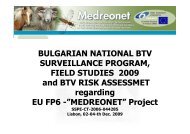Bayes - Medreonet
Bayes - Medreonet
Bayes - Medreonet
Create successful ePaper yourself
Turn your PDF publications into a flip-book with our unique Google optimized e-Paper software.
P(hypothesis) = probability of the hypothesis being true before<br />
we collect and analyze the set of data = PR prevalence of<br />
infection<br />
We test the animal and get a positive result. This is the data<br />
collection.<br />
P(data | hypothesis) = Likelihood function obtained after the<br />
experiment = probability of a positive test result (the data we<br />
got) given that the animal is infected (that's our hypothesis) = it<br />
is the Sensitivity of our diagnostic test!<br />
P(data) = Probability of all possible cases giving those data. A<br />
positive animal can be a either True positive or a False positive.<br />
Probability of being a True positive is PR times Sensitivity of the test<br />
Probability of being a False positive is (1-PR) times (1-Specificity of the<br />
test)<br />
so, the Predictive value of a positive result to a diagnostic<br />
test, i.e. the probability of our positive animal being infected is:<br />
P<br />
( )<br />
( hypothesis)<br />
⋅ P(<br />
data / hypothesis)<br />
PR ⋅ Sensitivity<br />
P hypothesis | data =<br />
=<br />
P( data) PR ⋅ Sensitivity + ( 1−<br />
PR) ⋅( 1−<br />
Specificity)





